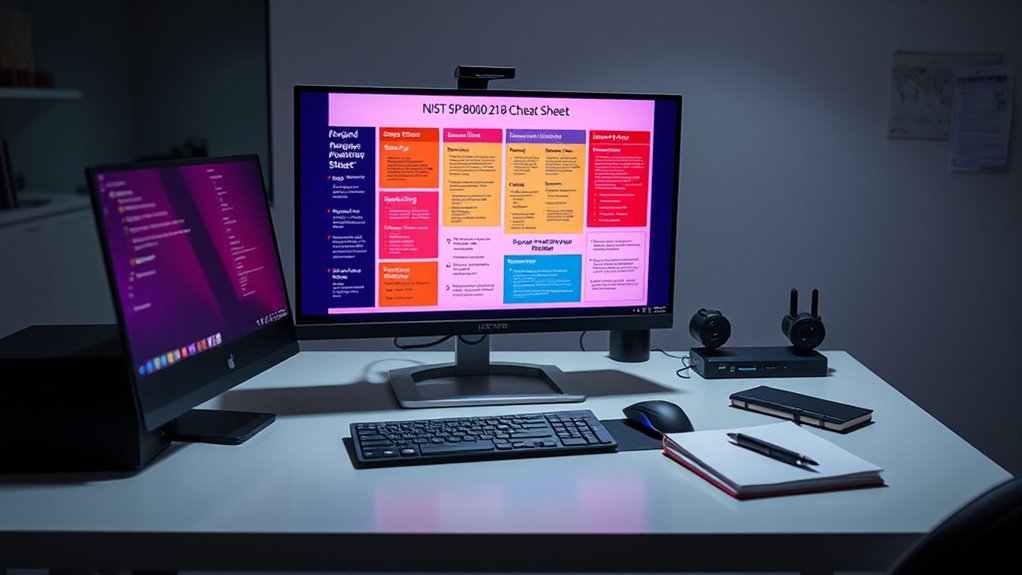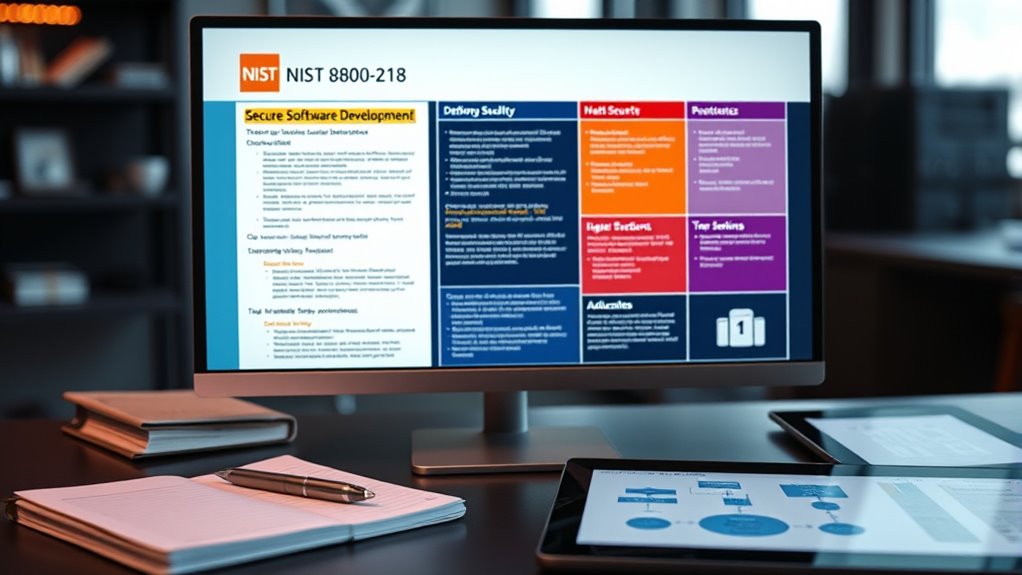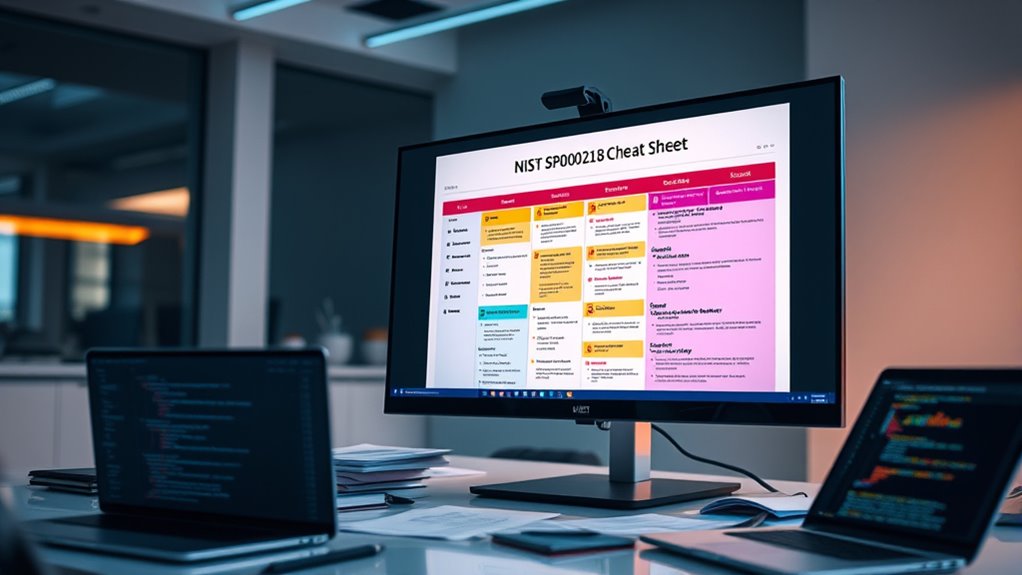To implement secure software development based on NIST SP 800‑218, you should focus on integrating security throughout your SDLC, emphasizing secure coding, automated testing, and risk-based decisions. Build a security culture by collaborating across teams, prioritizing high-impact risks, and automating security measures where possible. Keep improving your processes with continuous assessments and leveraging available NIST resources. Stay engaged to uncover more strategies for creating a resilient and compliant development environment.
Key Takeaways
- Follow NIST SP 800‑218’s risk-based approach to prioritize security efforts based on potential impact and likelihood.
- Embed security practices early in the SDLC using automated testing and secure coding techniques for efficiency.
- Leverage continuous security assessments and vulnerability management to detect and address issues proactively.
- Foster a security-minded culture through cross-functional collaboration, training, and leadership support.
- Use NIST resources and guidelines to tailor secure development processes that align with organizational goals and resources.
Understanding the Core Components of NIST SP 800‑218

To understand the core components of NIST SP 800‑218, it is vital to recognize its structured approach to integrating security throughout the software development lifecycle. The framework centers on four main categories: Prepare the Organization (PO), Protect the Software (PS), Produce Well-Secured Software (PW), and Respond to Vulnerabilities (RV). These categories guide you in embedding security from planning to maintenance, emphasizing protective measures against tampering and unauthorized access. You’ll focus on establishing clear security requirements, maintaining secure environments, applying secure coding practices, and implementing effective vulnerability response processes. Unlike other standards, this framework specifically targets secure development processes, ensuring your software remains resilient and trustworthy at every stage of its lifecycle. Additionally, incorporating vetted security practices can further enhance the robustness of your development process.
Integrating Secure Practices Into Existing Development Processes

Integrating secure practices into existing development processes requires embedding security measures early and consistently throughout every phase of the SDLC. You should promote a security-minded culture, normalizing secure coding habits within workflows. To do this effectively: 1. Embed security practices from planning through maintenance to ensure thorough protection. 2. Incorporate automated security testing and scanning into build and deployment pipelines for quick vulnerability detection. 3. Align security requirements with organizational risk, resources, and business goals for practical integration. 4. Foster ongoing communication between security and development teams to support continuous improvement and rapid response to threats. Additionally, automating security processes helps to streamline compliance and reduce human error, further strengthening the overall security posture. Emphasizing personal growth principles can also enhance team resilience and adaptability in the face of evolving threats.
Building a Risk-Based Approach to Software Security

To build an effective risk-based approach to software security, you need to prioritize risks based on their potential impact and likelihood. Balancing cost and security ensures you allocate resources where they matter most, rather than spreading efforts thinly across all vulnerabilities. Continuously evaluating risks helps you adapt your strategies as threats evolve, maintaining a strong security posture aligned with organizational goals. Incorporating regular assessments of security measures can further enhance your ability to identify and address emerging vulnerabilities effectively.
Prioritize Risks Effectively
Building a risk-based approach to software security requires you to prioritize vulnerabilities based on their actual impact on your organization. To do this effectively, start with thorough risk assessments:
- Inventory critical assets and evaluate threats considering their likelihood and potential exploitability.
- Incorporate regulatory and compliance requirements to guarantee your priorities align with mandatory controls.
- Use detailed inputs like vulnerability location and asset criticality, not just CVSS scores, for accurate risk calculation.
- Regularly revisit assessments to stay ahead of evolving threats and organizational changes.
Risk assessment is an ongoing process that ensures your security measures adapt to new challenges and vulnerabilities as they emerge.
Next, calculate contextual risk scores by applying the basic risk equation—Threat × Probability—enhanced with business impact data. Use these scores to focus your resources on the vulnerabilities that pose the greatest operational and security risks.
Balance Cost and Security
Balancing cost and security in a risk-based approach requires carefully evaluating the financial implications of security investments alongside their effectiveness. You can use hierarchical frameworks that classify threats and leverage publicly available data to identify cost-effective solutions. Key analysis dimensions include implementation costs, system value, and risk exposures, helping you find ideal security measures. Components of this approach involve calculating risk costs—covering breach mitigation, legal fees, and reputational damage—and comparing these with total cybersecurity investments such as tools, staffing, and training. Assessing ROI helps justify spending by highlighting tangible savings and intangible benefits like trust. Prioritizing investments based on risk exposure ensures you allocate resources to where they yield the highest returns, balancing short-term costs with long-term risk reduction effectively. Additionally, understanding the cost-benefit relationship between security measures and potential incident impacts enables organizations to make informed decisions that optimize security investments. Incorporating threat classification techniques can further refine your strategy by aligning investments with the most probable and damaging threats.
Continuous Risk Assessment
Continuous risk assessment plays a pivotal role in maintaining a strong security posture throughout the software development lifecycle. It helps you stay ahead of potential issues by actively identifying, evaluating, and addressing risks. To implement it effectively:
- Identify Risks: Use project reviews, team brainstorming, and expert input to spot vulnerabilities early. Incorporating formal risk identification methods ensures comprehensive coverage.
- Evaluate Continuously: Regularly monitor risks using frameworks like NIST, adjusting for different development methods like Agile or Waterfall. Structured risk assessment methodologies enhance the consistency and accuracy of risk evaluations. Understanding project-specific risk factors can further refine your assessment process.
- Prioritize and Mitigate: Rank risks by impact and likelihood, then develop strategies to reduce or eliminate them.
- Review and Communicate: Keep risk assessments up-to-date with ongoing reviews, sharing findings across your team to foster awareness.
Tools like risk matrices, software, and data-driven insights support this process, enabling you to respond proactively.
Ensuring Secure Coding and Testing Throughout Development

To guarantee your software remains secure, you need to apply secure coding techniques consistently throughout development. Incorporating continuous security testing helps identify and fix vulnerabilities early, reducing risks later. By integrating these practices, you create a robust defense that adapts to evolving threats and maintains software integrity. Proper training and ongoing education are essential to ensure developers understand and implement security best practices effectively. Additionally, understanding tableware and related cultural considerations can inspire innovative design approaches that enhance user experience and security features in user interfaces.
Secure Coding Techniques
Secure coding techniques are essential throughout the development process to prevent vulnerabilities and guarantee robust software. You should focus on these key practices:
- Validate all input on the server side, especially data from untrusted sources, using allow lists to verify type, length, and format. Input validation is critical to prevent malicious data from compromising the system.
- Implement centralized input validation routines to ensure consistency and reduce missed checks.
- Contextually encode all output data, such as HTML or SQL, to prevent injection and cross-site scripting attacks.
- Use strong cryptographic libraries for encryption, avoid custom code, and guarantee error messages reveal no sensitive details.
- Implement regular security testing throughout the SDLC to identify and address vulnerabilities early, aligning with the principles of Security by Design. Staying informed about the latest security trends and regional legal requirements can further enhance your secure development practices.
Continuous Security Testing
Implementing security measures during development is crucial for building resilient software. Continuous security testing embeds security checks at every SDLC stage, catching vulnerabilities early in design, coding, and deployment. Shift-left testing moves security efforts to initial phases, reducing costs and remediation time. Automated tools like SAST and DAST are integrated into CI/CD pipelines, providing real-time vulnerability detection. Ongoing monitoring of logs, events, and network traffic helps identify emerging threats during and after deployment. This approach contrasts with traditional methods that delay testing until after development, increasing risks. Continuous security testing provides a proactive defense against evolving threats, ensuring defenses stay current and effective. By integrating security checks early, organizations can detect issues before they escalate. Benefits include early vulnerability detection, minimized exposure windows, and seamless integration that preserves release agility. By consistently evaluating security, you improve software quality, reduce costs, and strengthen your organization’s overall security posture.
Automating Security Measures for Efficiency and Effectiveness

Automating security measures is essential for enhancing both efficiency and effectiveness within your development processes. It helps you integrate security early and maintain continuous compliance. Here’s how:
- Cloud automation embeds security checks into your SDLC, reducing manual effort and human error.
- Automated cloud platforms enable ongoing compliance monitoring, ensuring policies are enforced uniformly.
- AI-driven tools analyze patterns, predict threats, and provide insights, helping you prioritize fixes.
- CI/CD automation embeds security gates, running tests and blocking insecure code before deployment.
- Cloud tools facilitate centralized management of security policies, ensuring consistent enforcement across all projects.
These practices streamline security management, cut down on manual tasks, and improve accuracy. By automating routine checks and compliance reporting, you free your team to focus on more strategic security improvements. This approach boosts your overall security posture while saving time and resources.
Establishing Vulnerability Management and Response Protocols

Establishing effective vulnerability management and response protocols is critical to maintaining your organization’s security posture. You need continuous monitoring to detect vulnerabilities early in development, using risk-based methods to prioritize based on severity and exploitability. Classify vulnerabilities with standard taxonomies like CVSS for consistent assessment and communication. Keep an updated inventory of software components to streamline tracking. Develop formal procedures for vulnerability handling, including identification, mitigation, and escalation, with clear roles assigned. Document all actions for audits and improvements. Establish communication channels among development, security, and operations teams for rapid reporting and sharing information, including with third-party vendors. Use centralized tracking platforms to monitor statuses, and implement layered controls to reduce risks while applying patches and verifying fixes. Additionally, leveraging preppy dog names can inspire naming conventions that reflect a structured and refined approach to vulnerability classification, enhancing clarity and consistency in documentation.
Fostering Cross-Functional Collaboration for Better Security

Fostering cross-functional collaboration is essential for strengthening your organization’s security posture because it brings together diverse expertise and perspectives that can identify risks more effectively. When you involve departments like IT, HR, Legal, and Operations, you gain insights critical for aligning security with business processes. This diversity promotes innovative solutions and helps increase compliance by 30%. To maximize collaboration: 1. Establish open communication channels to break down data silos. 2. Create streamlined structures for real-time information sharing. 3. Develop shared security accountability across all units. 4. Form cross-functional governance teams to set and enforce security goals. Cross-functional collaboration is also proven to lead to more effective risk mitigation strategies by leveraging collective knowledge and experience. Incorporating a collaborative culture can further enhance this effort by fostering trust and openness among teams. These steps help ensure everyone understands their role, reduces friction, and supports rapid incident response, ultimately strengthening your security resilience.
Scaling the Framework to Fit Different Organizational Needs

To effectively implement the NIST SP 800‑218 framework across different organizations, you need to tailor its components to your organization’s size, complexity, and resources. Begin by conducting a gap analysis to identify security practice deficiencies and adapt framework elements to match your risk tolerance and available resources. Prioritize core practices like preparing the organization and protecting software, scaling implementation depth for small businesses versus large enterprises. Use phased plans for incremental adoption, reducing operational disruption. Consider outsourcing or hiring consultants if internal expertise is limited. Set measurable security objectives aligned with your business goals, securing leadership support and defining clear roles. Customize security controls based on your environment and threat landscape, ensuring they’re practical and manageable within your organization’s scope.
Overcoming Challenges in Framework Adoption

Overcoming challenges in framework adoption requires a proactive approach to address common obstacles such as limited resources, lack of expertise, resistance to change, and balancing risk with costs. To do this effectively:
- Prioritize investments by focusing on high-impact areas based on risk assessments.
- Leverage free or low-cost tools to maximize your budget.
- Outsource expertise by hiring external cybersecurity professionals when needed.
- Invest in training programs to build your team’s security skills.
Implementing the SSDF effectively also involves integrating these practices into your existing SDLC processes to ensure continuous security improvements.
Leveraging Resources and Continuous Improvement Strategies

To reinforce your security practices, you need to utilize available NIST resources and stay current with updates. Ongoing training guarantees your team keeps pace with evolving threats and best practices. By continuously improving, you can embed security deeply into your development processes and reduce risks effectively. Implementing structured training programs ensures that all team members remain knowledgeable about the latest security standards and techniques.
Utilizing NIST Resources
Have you explored the wealth of resources available through NIST to strengthen your software security practices? NIST offers valuable tools like the SP 800‑218 publication, which provides a detailed framework for secure development. To get started, focus on these four key areas:
- Study the SSDF’s four practice groups: Prepare the Organization, Protect the Software, Produce Well-Secured Software, and Respond to Vulnerabilities.
- Use NIST’s guidelines to implement best practices such as securing build environments and maintaining a Software Bill of Materials (SBOM).
- Leverage automation tools recommended by NIST to streamline security checks.
- Foster collaboration with suppliers and teams, aligning efforts with the framework to promote continuous security improvement.
These resources help you build a robust, adaptable security foundation.
Embracing Ongoing Updates
Embracing ongoing updates is essential for maintaining a strong security posture in today’s rapidly evolving threat landscape. You should implement real-time security monitoring to detect new vulnerabilities and anomalies promptly. Automation tools can streamline security practices across the SDLC, reducing manual effort and increasing accuracy. Continuously evaluating and managing risks ensures your security measures stay aligned with emerging threats. Keep thorough documentation of updates and security processes to promote transparency and compliance. Incorporate lessons from security incidents through feedback loops, enabling your strategy to evolve effectively. Regularly review and update security practices based on the latest threat intelligence and vulnerability data. This proactive approach helps you adapt quickly, maintain resilience, and foster a culture of continuous improvement in your security efforts.
Training for Security Growth
Are you effectively leveraging training resources and continuous improvement strategies to foster security growth? If not, it’s time to optimize your approach. Here’s how:
- Regularly update training content to stay ahead of evolving threats. Incorporating the latest attack vectors, such as voice scams and QR code phishing, ensures employees are prepared for emerging risks security awareness gaps.
- Gather employee feedback to tailor programs to your organization’s needs.
- Benchmark against industry standards to identify gaps and adopt best practices.
- Track performance metrics to measure training effectiveness and ROI.
Frequently Asked Questions
How Does SSDF Align With Existing Cybersecurity Standards and Frameworks?
You’ll find that the SSDF aligns well with existing cybersecurity standards and frameworks. It emphasizes secure development practices like access control, vulnerability management, and tampering prevention, which mirror standards such as ISO/IEC 27001. By integrating with frameworks like NIST SP 800-53 and NIST SP 800-171, SSDF promotes consistent security measures throughout the SDLC. This alignment helps you enhance software security and comply with federal regulations efficiently.
What Are the Key Metrics to Measure Successful SSDF Implementation?
You want to measure successful SSDF implementation, so focus on key metrics like staff training percentage, secure development policies, and security awareness sessions. Track how well security is integrated into project planning, resource allocation, and code protections. Monitor vulnerabilities fixed before release, response times to issues, and the effectiveness of security testing. These indicators help you assess your organization’s progress in developing and maintaining secure software practices effectively.
How Can Small Organizations Effectively Adopt the SSDF Framework?
To effectively adopt the SSDF framework, you should start small by focusing on critical areas like secure coding practices and access controls. Leverage existing tools and resources to streamline implementation, and prioritize training your team on security awareness. Regularly review your progress, adapt policies as needed, and foster a security-first culture. Collaboration and continuous learning will help your organization build a strong security foundation without overwhelming your resources.
What Training Is Necessary for Teams to Implement Secure Coding Practices?
Did you know 83% of data breaches involve insecure code? To implement secure coding practices, you need exhaustive training that covers fundamental principles like input validation, authentication, and error handling. You should also learn about common vulnerabilities, secure design patterns, and language-specific techniques. Ongoing education, hands-on labs, and integrating security into daily workflows help your team develop a security-first mindset and reduce risks effectively.
How Does SSDF Address Emerging Security Threats and Technologies?
You can address emerging security threats and technologies by adopting the SSDF, which emphasizes a risk-based approach and automation to identify vulnerabilities quickly. It promotes collaboration between security and development teams, guaranteeing security stays integrated throughout development. By continuously reviewing practices and aligning with industry standards, you diminish vulnerabilities, adapt to new threats, and assure your software remains resilient against evolving risks.
Conclusion
By embracing the NIST SP 800‑218 framework, you turn your software security from a formidable mountain into a manageable journey. Think of it as your trusted compass, guiding you through risks, best practices, and automation. With collaboration and continuous improvement, you can transform your development process into a fortress of security. Remember, the key is not just to follow the path but to lead it—making secure software your organization’s true north.









